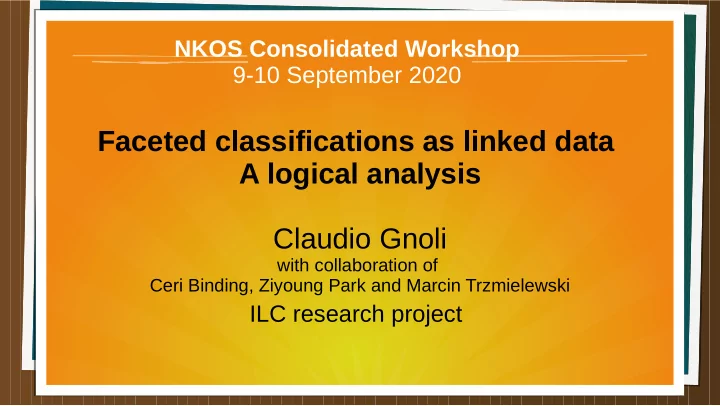

NKOS Consolidated Workshop 9-10 September 2020 Faceted classifications as linked data A logical analysis Claudio Gnoli with collaboration of Ceri Binding, Ziyoung Park and Marcin Trzmielewski ILC research project
Faceted classifications ● Semantically rich KOSs Many relationships, like in ontologies ● Many structural elements: basic classes, facet indicators, foci, phase relation’s... + rules: citation order, restrictions on foci... ● Representing them as linked data is then a demanding task
Integrative Levels Classification (ILC) ● A faceted classification based on phenomena ● Developed since 2004 by an international team ● ILC1 (7,052 classes+facets) published in 2011 ● ILC2 (10,845 classes+facets) published in 2019 ● ILC2 converted from MySQL to SKOS in 2019
Facets as linked data ● A facet expresses a relationship: xf 29 f painting, in country : Italy ● In the logic of linked data, this is a property in a triple: Subject property Object BasicClass facetIndicator Focus
Facets as linked data ● A facet can belong to a fundamental category e.g. ILC facet 29 “in country ” belongs to category 2 “in place ” ● In RDF terms, < 29> rdfs:subPropertyOf <2>
Multi-faceted classes ● xf99o29f “painting, baroque, in Italy” are equivalent to several RDF triples connected by intersection: xf99o ∩ xf29f “painting, baroque” “painting, in Italy”
RDF properties ● have a domain and a range: <29> a rdf:Property; skos:notation "29"^^xsd:string; skos:prefLabel "in country"@en; rdfs:label "in country"@en; rdfs:domain skos:Concept; rdfs:range <tt>; rdfs:subPropertyOf <2>.
What are the domain and range of a facet? ● ...It depends on what is meant by “facet”! ● In literature there is ambiguity between – facet as a semantic category (nature) – facet as a syntactic role (function) [Maniez 1999; Hudon 2019]
4 (+2) possibilities ● unrestricted domain / restricted range (to itself/other class) ● unrestricted domain / unrestricted range ● restricted domain / restricted range (to itself/other class) ● restricted domain / unrestricted range Let us use DDC examples
Common facets ● X 09 45 "any subject, in: Italy" unrestricted domain restricted range
Special facets 1 ● 786.2 1 83 "piano, musical form: sonata" restricted domain, restricted range ● Case 1: range is restricted to music itself ( bound s.f. ) ● Occur only in few DDC classes, such as music
Special facets 2 ● 782 3 45 "vocal music for service, of religion: Hinduism" restricted domain, restricted range ● Case 2: range is restricted to another class ( parallel special facets )
Special facets 3 ● 78 00 61 "music, in relation with: medicine" ● 02 6 34 "libraries, specializing in: law" restricted domain, unrestricted range ( free special f. )
Free facets ● X 015 X "any subject, principles: any science" ● 620.0 015 3 ”engineering, principles: physical” unrestricted range, unrestricted domain ● Only available with sciences ( 015 ) in DDC ● but could easily be extended to any class e.g. using 00 + 001/999 !
Facet types ● Common facets – Bound : d. unrestricted, r. restricted to domain – Parallel: d. unrestricted, r. restricted to other class – Free : d. unrestricted, r. unrestricted ● Special facets – Bound : d. restricted, r. restricted to domain – Parallel : d. restricted, r. restricted to other class – Free : d. restricted, r. unrestricted
Facet types ● ILC has ways to distinguish them in notation ...just trust me ;-) ● These are reflected in SKOS version of ILC by definitions of domains and ranges
Conclusions ● Facets can be expressed in RDF as properties ● They can be subproperties of fundamental categories ● Multi-faceted compounds = Intersections of triples ● The need to express ILC in SKOS stimulated a more formal distinction of facet types ● Other classifications can benefit of such analysis and introduce more facet types, e.g. free facets by -00- in DDC
...Thanks! ● iskoi.org/ilc ● iskoi.org/ilc ● iskoi.org/ilc ● iskoi.org/ilc ● iskoi.org/ilc ● iskoi.org/ilc <http://www.iskoi.org/ilc/2/class/d93> a rdf:Property; rdfs:domain <http://www.iskoi.org/ilc/2/class/d>; rdfs:label "attracted by fundamental ● T: @scritur ● T: @scritur ● T: @scritur ● T: @scritur ● T: @scritur ● T: @scritur interaction"@en; rdfs:range <http://www.iskoi.org/ilc/2/class/daf>; ● claudio.gnoli@unipv.it ● claudio.gnoli@unipv.it ● claudio.gnoli@unipv.it ● claudio.gnoli@unipv.it ● claudio.gnoli@unipv.it ● claudio.gnoli@unipv.it rdfs:seeAlso <http://www.iskoi.org/ilc/2/details.php?no=d93>; rdfs:subPropertyOf <http://www.iskoi.org/ilc/2/class/d9>; <http://www.w3.org/2004/02/skos/core#altLabel> "attracted by force"@en; <http://www.w3.org/2004/02/skos/core#notation> "d93"^^xsd:string; <http://www.w3.org/2004/02/skos/core#prefLabel> "attracted by fundamental interaction"@en.
Recommend
More recommend